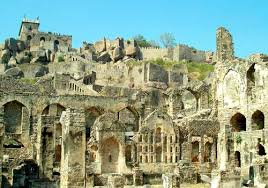What
is ruin porn?
3. The Char Minar
Now regarded as one of the supreme architectural achievements of the Quṭb Shāhī period, the Charminar is a grand architectural composition in Indo-Saracenic style. It is built of granite and lime mortar with stucco ornamentation.
6. Martand Sun Temple, Kashmir
7. Maluti Temples, Jharkhand
Ruin
porn is a sexy name for a contentious genre of
photography. It consists of images of abandoned places, photos that are
hauntingly different.
Therefore, ruin porn is basically for
the buildings that can not be completely restored. For example, Hyderabad in
India, there are ancient building and surface of them has been ruined but the
texture still remains artistically compelling. An exposed surface of stone
appears so appealing than the painted one.
Why is ruin porn becoming popular?
The ruins have since been the subject of much obsession, including
numerous articles, photographic essays
and online galleries.
The allure of ruin remains prominent in tourism and popular culture,
including abandoned amusement parks such as Sydney's Magic Kingdom park,
Germany's Cold War-era Spree park, and Japan's Takakanonuma Greenland in the
Fukushima district. Photographers who capture these sites have a name: "urban explorers", and many keep diaries of
their discoveries on social media platforms.
 |
| Who is Bhim Rao Ambedkar? |
Many of
Hyderabad's historical landmarks, like the medieval Golconda Fort and the Qutb
Shahi tombs, have been a magnet for 'ruin porn' even before the phrase was
coined.
Hyderabad’s Qutb Shahi tombs, Golconda Fort and Charminar
were added to the list of tentative sites, but nothing more has been heard
about the progress. However, Hyderabad has rapidly become a spot for ruin porn
or ruin photography
The Origin of the Ruin Porn?
The term has cropped up with increasing regularity in the last few
years. The ruins of Chernobyl, the Holocaust, Detroit's urban decay, and even
abandoned amusement parks have become havens for "ruin
photographers".
In his recent book The Cambridge Introduction to
Postmodernism (2015), US theorist Brian McHale claims that
artist Robert Smithson's work acts as a precursor to ruin
porn. He argues that the photographic documentation of ruin "arguably
begins with Smithson's deadpan photographs of modern industrial wastelands in
his conceptual-art project A Tour of the Monuments of
Passaic, New Jersey."
The term ‘ruin porn’ has been popular
due to internet and the history does not much information about it.
The significance
of ruin porn
Ruin sites provide
something of a realistic glimpse into post-apocalyptic life for humanity, and
hence provoke our engagement with ruin while we are still alive.
Ruins appear
to confront society's faith in anthropological endurance. Decaying buildings
signify the inevitable process of history, to which we, too, will eventually
succumb. Essentially, 'ruin porn' is a kind of time travel to the future within
the present.
While ruin
porn greatly trivializes the social and psychological implications of decay, it
can be understood more broadly as something of an antidote to the bleak reality
of inevitable, complete destruction, something more depressing than beautiful.
The best places to visit for ‘Ruin
Porn in India’
Hyderabad remains a famous tourist attraction for ruin
porn, and there are certain sites which are famous. There are few sites which
are having major tourist attraction.
1. Qutb Shahi Tombs
Qutb Shahi Tombs, a series of seven
tombs belonging to the Qutubuddin Dynasty, is an important heritage site in
Hyderabad.
Constructed in the 1500’s, Qutb
Shahi Tombs draw tourists for its exceptional architecture, which blends
Persian and Hindu styles. The tombs, a burial ground of the Qutubuddin Dynasty,
teleport people back in history. Its intricate arches and stonework are truly
delightful.
2.
Golkonda Fort
Golconda Fort Hyderabad is an outstanding example of brilliant
engineering and magical architecture. Located at a distance of 11km from the
city, it is the most famous of all Hyderabad sightseeing places.
 |
The Golkonda Fort
Source- wikipedia
|
The name of the fort has been
derived from the Telugu words "Golla" and "Konda" which
together means 'Shepherd's Hill'.
Founded in the approximately 12th Century by the Kakatiya Kings, this massive Golconda Fort with eight gates and 87 bastions was later built by Qutub Shahi Kings.
Founded in the approximately 12th Century by the Kakatiya Kings, this massive Golconda Fort with eight gates and 87 bastions was later built by Qutub Shahi Kings.
Golconda fort timings are from 9 am
to 5.30 pm and the entry is free.
3. The Char Minar
The monument was built in 1591
by Muḥammad Qulī Quṭb Shah, the fifth king of the Quṭb Shāhī dynasty, reportedly as the
first building in Hyderabad, his new capital. Over the years, it has become a
signature monument to and an iconic
symbol of the city’s heritage.
 |
The Char Minar of Hydrabad
Image Source- wikipedia
|
According to one legend, the
Hyderabad region was reeling from a devastating plague at the time that Muḥammad Qulī Quṭb Shah was shifting his capital
from nearby Golconda to the new city.
He commemorated
the end of the plague by building a mosque, which became known as Charminar
because of its four towering and distinctive minarets, one on each of the
building’s four corners. It formed the centrepiece around which Hyderabad was
planned
 |
| Get Your App Now |
Now regarded as one of the supreme architectural achievements of the Quṭb Shāhī period, the Charminar is a grand architectural composition in Indo-Saracenic style. It is built of granite and lime mortar with stucco ornamentation.
The square structure measures
66 feet (20 metres) to a side. Each side faces one of the cardinal directions
and has a pointed arch that is 36 feet (11 metres) wide at the base and reaches
66 feet high at its apex.
A multisided column rises on each corner of
the structure and, atop a lotus-leaf base, continues upward until it culminates
in a minaret with a dome-shaped roof 160 feet (49 metres) above the ground.
Each minaret is accessed via a spiral staircase on its interior wall and
consists of four levels, each of which features a delicately colonnaded covered
walkway around the exterior wall.
Above the arches of the main structure are two
stories. The first was once used as a madrasah (Islamic college) in the Quṭb Shāhī era, and the second houses a
small mosque.
In addition to the mosque, the Charminar has
45 other prayer areas. The Charminar’s roof and minarets afford panoramic views of
Hyderabad, notably the historic Golconda Fort to the west and the bustling Lad
Bazaar—adjacent to the Charminar—which is famed for its traditional lacquer
bangles studded with coloured glass and stones.
4. Feroz Shah Kotla Delhi
A pristine polished sandstone Topra
Ashokan pillar from the 3rd century B.C. rises from
the palace's crumbling remains, one of many pillars of Ashoka left by the Mauryan emperor; it was moved from Topra Kalan in Pong Ghati of Yamunanagar district in Haryana to
Delhi under orders of Firoz Shah Tughlaq of Delhi Sultanate, and re-erected in
its present location in 1356.
 |
The ruins of Feroz Shah Kotla Delhi
Image Source- Wikipedia
|
The original inscription on the obelisk is primarily in
Brahmi script but language was prakrit, with some Pali and Sanskrit added
later. The inscription was successfully translated in 1837 by James
Prinsep.
5.
Nalanda
university, Bihar
Nalanda University is a UNESCO world heritage site is
located South Bihar. Considered as one of the oldest universities in the world
and known as Nalanda Mahavira back in time, its origins date back to the 3rd
century. Mahavira is a Sanskrit term for a great 'Vihara'(Buddhist Monastery).
 |
Nalanda university, Bihar
Image Source- cultural India
|
Located about 85 km away from Patna, it is regarded as one
of the greatest and oldest universities recorded in history. It finds
references in the oldest epics of India as well as in the travels of Hiuen
Tsang.
The Gupta kings built various monasteries in old Kusan
style of architecture. Emperor Ashoka and Emperor Harshavandhana were also
patrons of this university who built few temples, viharas, and monasteries for
the university. Former President Dr. APJ Abdul Kalam pitched the idea of
reviving the university in March 2016.
6. Martand Sun Temple, Kashmir
Martand Sun Temple, a spectacular shrine dedicated to Surya (the
Sun), lies at a distance of over five miles from Anantnag in the heavenly state
of Jammu and Kashmir, India.
 |
Martand Sun Temple, Kashmir
Image Source- holidify
|
This structure is a Kashmiri Hindu Temple and is known as one of
the most elegant structures ever built in India. Even in a wrecked state, the
temple shares it’s story with the ones who genuinely want to listen.
The architecture is breathtaking and the vibe somewhat nostalgic
but so enticing that it makes travellers want to come here. A walk across the
courtyard is a must for visitors to notice the brilliantly fused designs and
carvings on the structure that still stand the tests of time and weather.
It was built in 6th or 7th centaury.
A small town in the pockets of Jharkhand, Maluti boasts of as
many as 72 temples. Built as edifices to the Pala Dynasty rulers, the temple
architecture depicts scenes from the great epics of Ramayana and Mahabharata.
 |
Maluti Temples, Jharkhand
Image Source- holidify
|
It is said that
originally, 108 temples were constructed by the rulers who decided to build
temples instead of palaces, as a result, Maluti came to be known as the temple
town. However, after the fall of the dynasties, the later generations could not
maintain all the 108 temples and 36 of which deteriorated and crumbled to the
ground.
The existing temples are in a state of ruins because of lack of funds to undertake the repair. Global Heritage Fund declared it to be one of the 12 worldwide sites nearest of irreparable loss.
The existing temples are in a state of ruins because of lack of funds to undertake the repair. Global Heritage Fund declared it to be one of the 12 worldwide sites nearest of irreparable loss.













No comments:
Post a Comment